Cornelis van der Geest
Cornelis van der Geest (1575 – 10 March 1638) was a spice merchant from Antwerp, who used his wealth to support the Antwerp artists and to establish his art collection. He was also the dean of the haberdashers guild.[1]

Art collection
He is best known today for his art collection.[2] He was portrayed repeatedly by Anthony van Dyck, while Willem van Haecht, who he had hired as curator, painted his "constcammer" several times, including a view of the visit of Albert VII, Archduke of Austria and Isabella Clara Eugenia to his art collection.
He owned two paintings by Quentin Matsys, one of which, a Madonna, can be seen in the Van Haecht painting. Other works included in that view are Women at her toilet by Jan van Eyck, a still life by Frans Snyders, Ceres Mocked by Adam Elsheimer, Danaë by Van Haecht, Battle of the Amazons and a portrait by Peter Paul Rubens, Peasant Company with Woman making Pancakes by Pieter Aertsen, Apelles by Jan Wierix and a hunting scene by Jan Wildens. The painting also shows some of Van der Geest's sculptures, with copies of the Venus de' Medici, the Farnese Hercules, and the Apollo Belvedere.[3]
Paintings by Willem van Haecht of his art gallery:
 (1) Collection of Cornelis van der Geest with Joseph and Potiphar's wife, c. 1630
(1) Collection of Cornelis van der Geest with Joseph and Potiphar's wife, c. 1630 (2) Alexander the Great visits the studio of Apelles, c. 1630
(2) Alexander the Great visits the studio of Apelles, c. 1630_-_Apelles_painting_Campaspe_-_2.jpg) (3) Apelles painting Campaspe, c. 1630
(3) Apelles painting Campaspe, c. 1630 (4) Paracelsus in the Gallery of Cornelis van der Geest, 1620-1637
(4) Paracelsus in the Gallery of Cornelis van der Geest, 1620-1637- (5) Albert and Isabella visiting the Gallery of Cornelis van der Geest, 1628
- (5) Left side detail: portraits of Isabella and Archduke Albert, Rubens, Prince Władysław Vasa of Poland (who visited van der Geest's Gallery in 1624, with black hat) and the host showing the Matsys Madonna
Paintings hanging in his art gallery followed by the numbers of the five gallery paintings above:
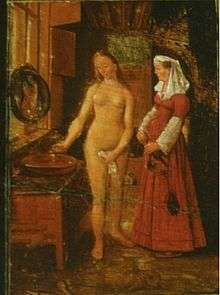 Woman at her Toilet by Jan van Eyck (5)
Woman at her Toilet by Jan van Eyck (5)_or_workshop_001.jpg)
 Ceres Mocked, by Adam Elsheimer (5)
Ceres Mocked, by Adam Elsheimer (5).jpg) Judith and Holofernes, by Adam Elsheimer (3 & 5)
Judith and Holofernes, by Adam Elsheimer (3 & 5) The Pancake Bakery, by Pieter Aertsen (5)
The Pancake Bakery, by Pieter Aertsen (5) Pigrims at Emmaus by Paul Bril (4)
Pigrims at Emmaus by Paul Bril (4)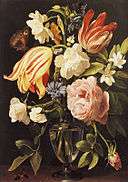 Flowers in a Vase, by Daniel Seghers (2,3 & 4)
Flowers in a Vase, by Daniel Seghers (2,3 & 4) Game Larder Still Life with a Page Holding a Parrot, by Frans Snyders (1,2,3 & 5)
Game Larder Still Life with a Page Holding a Parrot, by Frans Snyders (1,2,3 & 5) Portrait of a Scholar, by Quentin Matsys (2,3 & 5)
Portrait of a Scholar, by Quentin Matsys (2,3 & 5)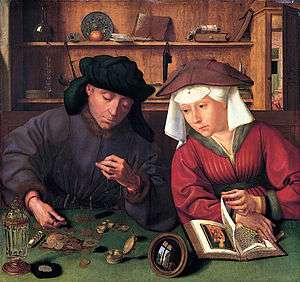 The Money Changer and His Wife, by Quentin Matsys (3)
The Money Changer and His Wife, by Quentin Matsys (3)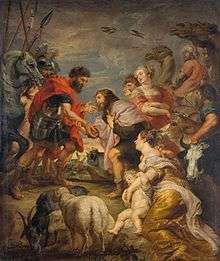 The Reconciliation of Esau and Jacob, by Rubens, (1)
The Reconciliation of Esau and Jacob, by Rubens, (1) Battle of the Amazons by Rubens (3 & 5)
Battle of the Amazons by Rubens (3 & 5)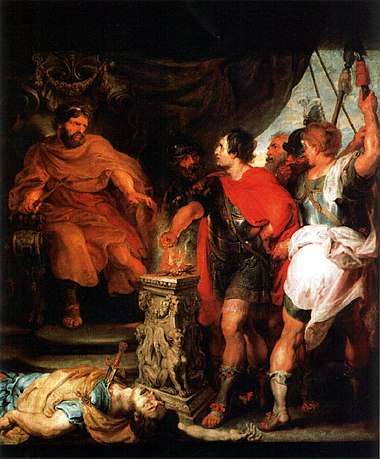 Mucius Scaevola before Porsenna, by Rubens (4)
Mucius Scaevola before Porsenna, by Rubens (4)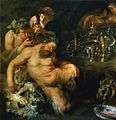 The Drunken Satyr, by Rubens (2,3 & 4)
The Drunken Satyr, by Rubens (2,3 & 4)%2C_Portrait_of_a_commander%2C_Christie's_Images.jpg) Portrait of a Commander, by Rubens (5)
Portrait of a Commander, by Rubens (5)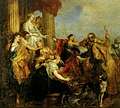 Achilles recognized among daughters of Lycomedes, by Anthony van Dyck (2)
Achilles recognized among daughters of Lycomedes, by Anthony van Dyck (2)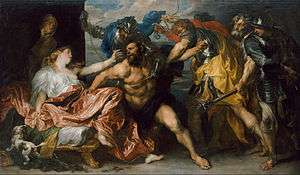 Samson and Delilah by Anthony van Dyck (3)
Samson and Delilah by Anthony van Dyck (3) Portrait of Ferry Carondelet with his Secretaries, by Sebastiano del Piombo, (1,2,3 & 4)
Portrait of Ferry Carondelet with his Secretaries, by Sebastiano del Piombo, (1,2,3 & 4)- Roman Soldier and Servant, by Bernaert van Orley, (2,3 & 4)
 Apollo and Daphne, by Francesco Albani, (1 & 3)
Apollo and Daphne, by Francesco Albani, (1 & 3) Spring, by Hans Rottenhammer, (2,3,4 & 5)
Spring, by Hans Rottenhammer, (2,3,4 & 5) Last Judgement, by Hans Rottenhammer, (5)
Last Judgement, by Hans Rottenhammer, (5)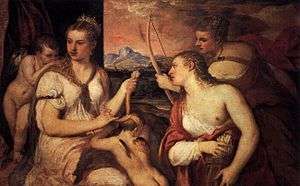 Venus Blindfolding Cupid, by Titian (2,3 & 4)
Venus Blindfolding Cupid, by Titian (2,3 & 4) Venus and Cupid with a Satyr, by Correggio (2,3 & 4)
Venus and Cupid with a Satyr, by Correggio (2,3 & 4) The Last Supper, by Otto van Veen, (4 & 5)
The Last Supper, by Otto van Veen, (4 & 5) Winter Landscape, by Jan Wildens (5)
Winter Landscape, by Jan Wildens (5) Kranenhoofd on the Schelde in Antwerp, by Sebastian Vrancx (5)
Kranenhoofd on the Schelde in Antwerp, by Sebastian Vrancx (5) The Rape of Europa, by Hendrick van Balen (2 & 3)
The Rape of Europa, by Hendrick van Balen (2 & 3) The Bean Eaters, by Vincenzo Campi (3)
The Bean Eaters, by Vincenzo Campi (3) Death of Cleopatra, by Guido Reni (3)
Death of Cleopatra, by Guido Reni (3)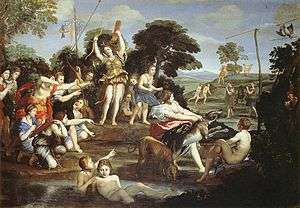 Diana and her Nymphs, by Domenichino (3)
Diana and her Nymphs, by Domenichino (3) Couple with a Mirror, (1,3 & 4)
Couple with a Mirror, (1,3 & 4) Venus in the Forge of Vulcan, by Felice Riccio (2,3 & 5)
Venus in the Forge of Vulcan, by Felice Riccio (2,3 & 5) Lost portrait of Paracelsus, by Quentin Matsys (5)
Lost portrait of Paracelsus, by Quentin Matsys (5)
Maecenas
Van der Geest also functioned as a maecenas. He arranged for Rubens to get the order for a triptych for the Saint Walpurga church in Antwerp, which resulted in the Elevation of the Cross, now in the Cathedral of Antwerp.[4] Similarly, the order for the 1630-1632 Triptych of Saint Ildephonsus, intended for the Saint James church, but now in the Kunsthistorisches Museum in Vienna, was given to Rubens through the influence of Van der Geest.[1] Van der Geest also financed a new memorial for Quentin Metsys against the tower of the Antwerp Cathedral.[5]
See also
- Portrait of a Commander, a possible portrait of van der Geest
Notes
- Giorgi, Rosa (2008). European art of the seventeenth century. Getty Publications. p. 383. ISBN 978-0-89236-934-8.
- "Kamers vol kunst in 17de eeuws Antwerpen". Rubenshuis. Archived from the original on 22 December 2015. Retrieved 17 December 2015.
- Sutherland Harris, Ann (2005). Seventeenth-century art & architecture. Laurence King Publishing. p. 426. ISBN 978-1-85669-415-5.
- Timmermans, Bert (2008). Patronen van patronage in het zeventiende-eeuwse Antwerpen (in Dutch). Amsterdam University Press. p. 250. ISBN 978-90-5260-247-9. Retrieved 23 July 2016.
- Geschiedenis der Antwerpsche rederykkamers, chapter 1, Geschiedenis der violieren, by J. B. Van Der Staelen, 1834
External links
| Wikimedia Commons has media related to Cornelis van der Geest. |
- Love in the Kunstkamer in fine arts magazine Tableau, by Gary Schwartz
- Willem van Haecht schilderde in 1628 de constkamer van cornelis van der geest; een multi-interpreteerbaar tijdsdocument, Dutch article about painting (5) in magazine Vlaanderen, Jaargang 43, 1994